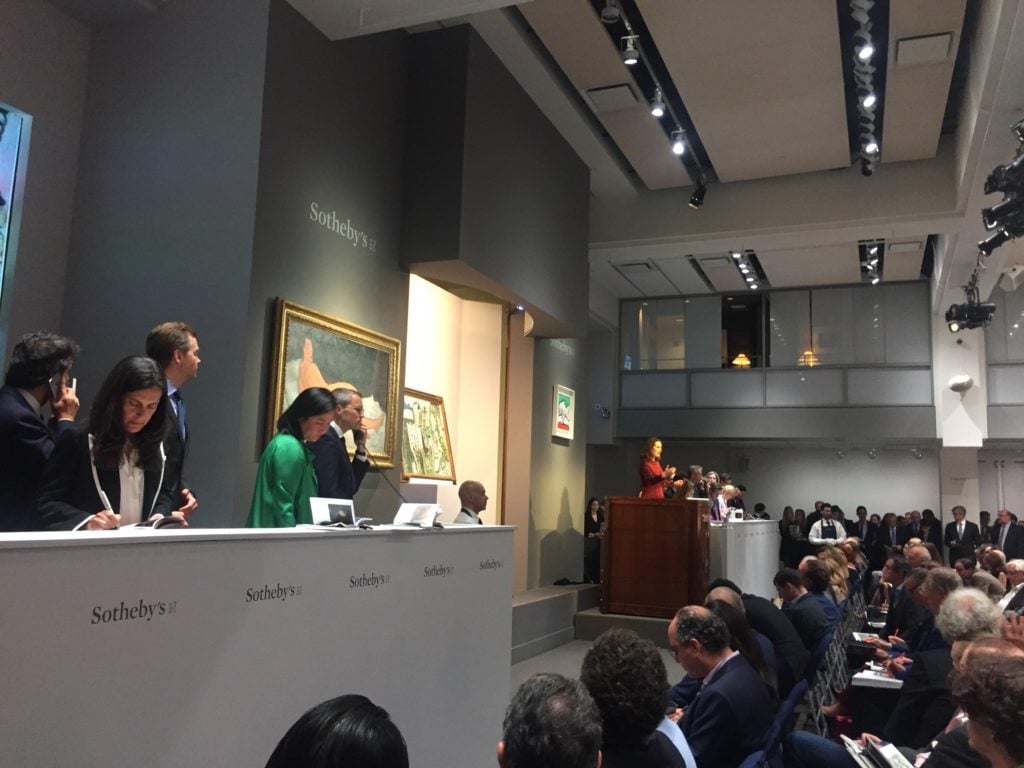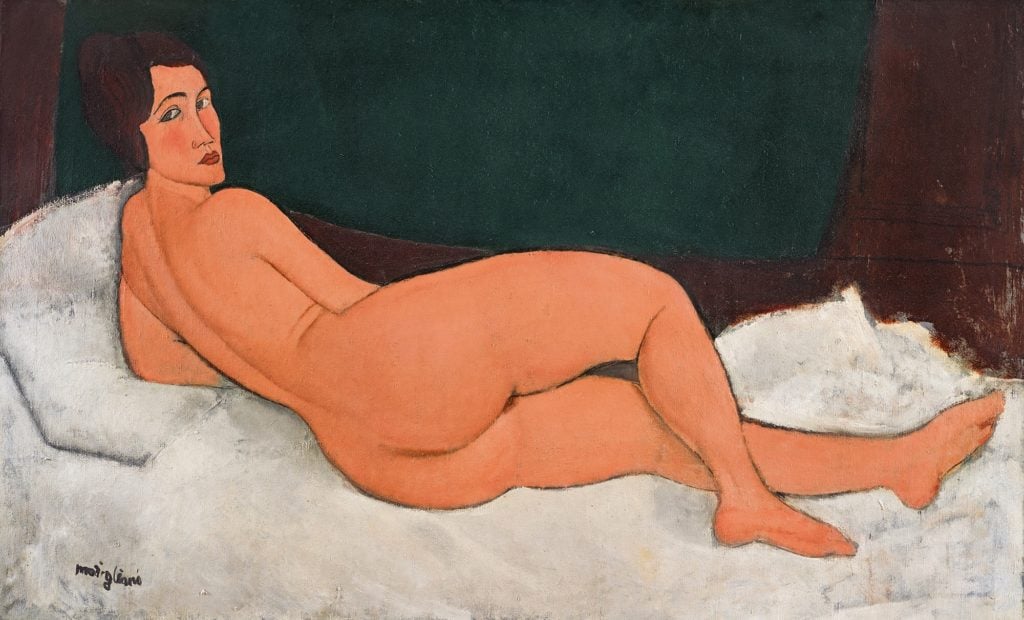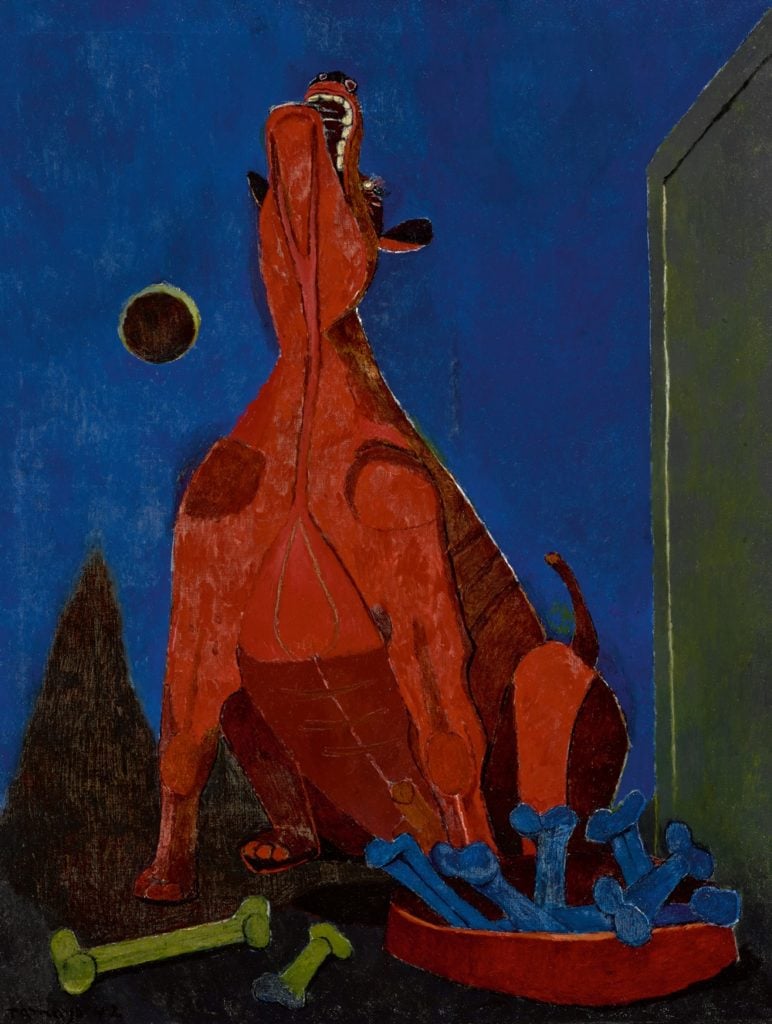Auctions
Led by a $157 Million Modigliani, Sotheby’s Otherwise Tepid Impressionist Sale Makes $318 Million
The much-anticipated Modigliani became the fourth most expensive work ever sold at auction—even if the rest of the sale felt sleepy.

The much-anticipated Modigliani became the fourth most expensive work ever sold at auction—even if the rest of the sale felt sleepy.

Eileen Kinsella

Sotheby’s evening sale of Impressionist and Modern art was a study in contrasts. The auction saw a nude by Modigliani become the fourth most expensive work of art ever sold at auction. Despite the nine-figure sale, however, the evening was—somehow—a muted affair.
All told, the evening generated $318.3 million, toward the low end of its pre-sale estimate of $307.4 million to $378.1 million. (Final prices, unless noted, include premiums; pre-sale estimates do not.)
The top lot of the night—and one of the most buzzed-about this season—was Amedeo Modigliani’s large nude Nu couché (sur le côté gauche) (1917), which carried a $150 million estimate, the most expensive ever placed on a single work at auction. It also had an irrevocable, or third-party, bid placed in advance. The work sold for a premium-inclusive price of $157 million after sparse bidding.
All told, the evening made considerably more than the $173 million realized at the equivalent sale last spring, which was marred by the last-minute withdrawal of a star lot. But the salesroom failed to ignite the fireworks felt during last week’s marquee Rockefeller sale at Christie’s.
Though the auction on the whole delivered a healthy total and the Modigliani also became the most expensive work of art ever sold at Sotheby’s, the star lot failed to meet its low estimate and numerous other works were bought in or sold for below estimate, even with their premiums. Of 45 lots on offer, 32, or 71 percent were sold.

Amedeo Modigliani, Nu couché (sur le côté gauche) (1917). Courtesy Sotheby’s.
As much as it is possible to say that a nine-figure artwork had a lackluster performance, this one did. Auctioneer Helena Newman opened the bidding at $125 million but there did not appear to be immediate demand. Newman paused repeatedly—at $135 million and again at $138 million and $139 million—but to no avail. Eventually, the head of the Impressionist and Modern department, Simon Shaw, bumped the price up to a final bid of $139 million.
Sources said the work sold to the third-party guarantor. At a post-auction press conference, Shaw said the house could not comment on the identity of the buyer.
The painting—the largest ever made by Modigliani—was consigned by Irish collector and horse breeder John Magnier, who paid $26.9 million for it in 2003. (At the time, it was believed to have been consigned by casino mogul Steve Wynn.) Tonight’s price marks a gain for Magnier of $130.3 million, or 484 percent. But the work failed to surpass Modigliani’s own record of $170.4 million, set at Christie’s in 2015.
Meanwhile, two lots offered for sale by the Berkshire Museum of Art—a controversial deaccession that led to a protracted legal battle and caused some advocates to protest outside the auction house before the sale—saw mixed results.
Henry Moore’s painting Three Seated Women (1942) was estimated at $400,000 to $600,000 and sold for an under-estimate $300,000. Francis Picabia’s Force Comique (1914) sold for $1.1 million with premium, just missing its high estimate of $800,000 to $1.2 million. Combined, they generated $1.4 million toward the museum’s goal of $50 million.
Another highly anticipated lot was Pablo Picasso’s Le Repos (1932), estimated at $25 million to $35 million. The painting—previously won by Sue Gross in a highly contested divorce with Wall Street kingpin Bill Gross and now sold to benefit her foundation—depicts the artist’s so-called “golden muse” Marie Thérèse Walter.
The painting last appeared at auction nearly two decades ago, when it sold at Sotheby’s in 2000 for $7.9 million, according to the artnet Price Database. Tonight, it sold for $36.9 million after a volley of bids. The winning number—$32.5 million—was delivered by Patty Wong, senior director and chairman of Sotheby’s Asia. Sotheby’s confirmed that a private Asian collector had bought the work.
Another rare strong spot was Georgia O’Keeffe’s moody landscape Lake George With White Birch (1921), which had been in the same collection for more than 30 years and sold for $11.3 million, well above its high estimate of $6 million.
Many of the top lots in the sale had recent and not-so-recent previous auction sales, which always provides an interesting barometer of the evolving market. For example, Claude Monet’s Matinée Sur La Seine (1896)—estimated at $18 million to $25 million—sold for $20.6 million. It last appeared at auction in November 2000, also at Sotheby’s, when it sold for $5.7 million on an estimate of $6 million to $8 million.
Another Picasso, however, did not enjoy such an appreciation. Pablo Picasso’s Femme au Chien (1953), estimated at $12 million to $18 million, was last offered at auction at Sotheby’s more than 30 years ago, when it sold for $2.4 million. This evening, bidding opened at $9 million and stalled at around $11 million. The work was painted during a tumultuous time in the artist’s life, six months before the breakdown of his relationship with Françoise Gilot, his lover of 10 years. It ultimately failed to sell.
Another Picasso, this one from the artist’s early Rose period (the same that produced the $115 million Picasso sold at the Rockefeller sale last week), performed better but still missed its low estimate. With premium, it sold for $11.6 million on an estimate of $12 million to $18 million. The current owner acquired the work, Famille d’arlequin (1905), just over a decade ago at Sotheby’s New York for $9.8 million.
After a wave of rapid-fire Picasso sales in recent months, is it possible the market has become choosier? Of 11 Picassos on offer, only six, or roughly half, found buyers for a total of $63.6 million. Three of those six, however, figured into the evening’s top 10 lots.

Rufino Tamayo, Perro aullando a la luna (Dog Howing at the Moon (1942).
©Tamayo Heirs/Mexico/Licensed by VAGA, New York, NY. Courtesy Sotheby’s.
Meanwhile, Rufino Tamayo’s Perro aullando a la luna (Dog Howing at the Moon (1942) was another notable work that came in at the low end of expectations. Estimated at $5 million to $7 million and never before seen at auction, the work also marked the formal integration of Latin American art into Sotheby’s Impressionist and Modern art sales for the first time. It drew several bids, before it was hammered down at $5 million, or $5.9 million with premium.
Modigliani is likely to be the biggest-ticket lot of the week. And despite the shallow demand, Simon Shaw of Sotheby’s was sanguine. “Modigliani has now joined the ultimate club within the art market at $150 million,” he said at a post-sale press conference. “He’s the only artist who has broken that ceiling twice.”
Nevertheless, the larger sale totals are expected to come in a few days, when the three major houses hold their contemporary art sales. “Christie’s set the bar for the auction season with its sale of blue chip works from the blue-blooded Rockefellers,” noted art lawyer and commentator Thomas Danziger after the sale. “Fortunately for Sotheby’s, their star Modigliani sold well—though without much energy or evident enthusiasm in the auction room. The true test for both houses will come later this week with the postwar and contemporary sales.”